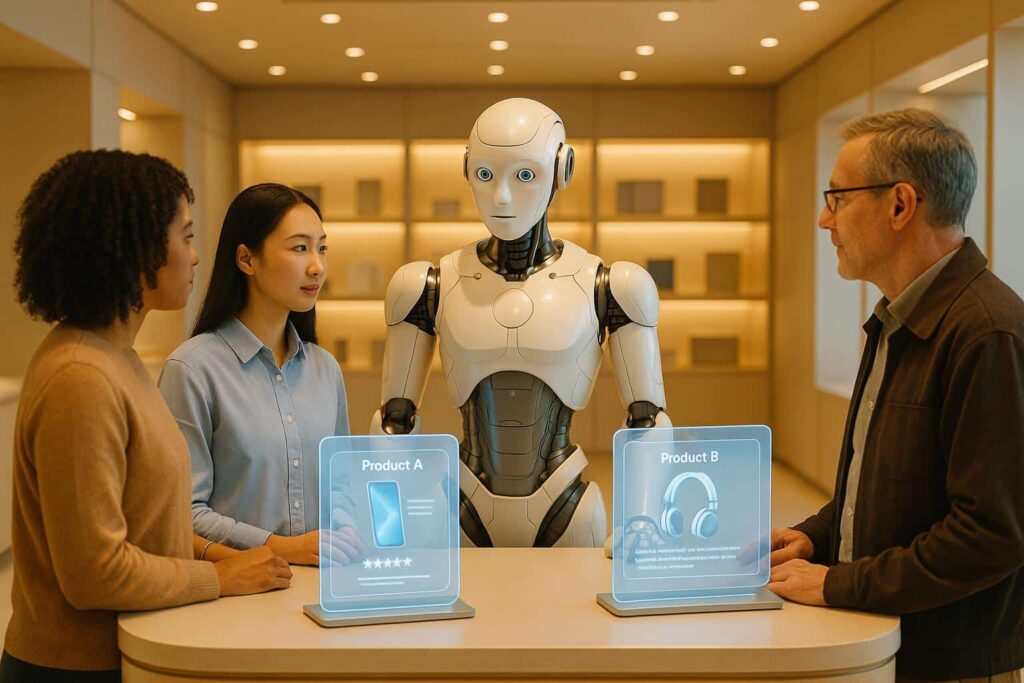Generative AI is transforming how businesses interact with customers by delivering personalized experiences at scale. Unlike older AI methods that rely on static rules, generative AI creates tailored content, recommendations, and real-time adjustments based on individual preferences and behaviors. Here’s a quick breakdown:
- What It Does: Generates new content (text, images, etc.) and customizes customer interactions.
- Why It Matters: 80% of consumers prefer personalized experiences, and companies using AI-driven personalization see increased revenue and reduced costs.
- How It Works: Analyzes customer data (browsing habits, purchase history) to deliver hyper-targeted recommendations, dynamic website changes, and predictive insights.
- Results: Businesses report higher conversion rates, improved customer satisfaction, and faster ROI.
Generative AI isn’t just improving customer journeys – it’s reshaping how brands connect with their audiences.
Hyper-personalized customer journeys powered by analytics and generative AI | Amazon Web Services

How Generative AI Transforms Customer Journey Personalization
Generative AI goes beyond simply analyzing customer data – it actively creates tailored experiences for every individual who interacts with your brand. From the very first email to the final purchase confirmation page, AI is revolutionizing how brands engage with their customers. Let’s dive into how this technology is reshaping customer touchpoints with personalized content, smarter recommendations, and dynamic interface adjustments.
Creating Personalized Content
Generative AI has the ability to craft content that feels genuinely personal. Unlike traditional tools that rely on pre-written templates, this technology generates entirely new content based on individual preferences, behaviors, and needs.
By analyzing data like browsing habits, purchase history, and engagement patterns, AI can create messaging that resonates on a personal level. For instance, in March 2023, L’Oréal demonstrated the power of AI-driven content by saving 120,000 hours of manual work while simultaneously improving their search engine optimization efforts. This shows how AI can produce more targeted content at scale without compromising quality.
The business impact is hard to ignore. A 2021 study found that 88% of marketers observed measurable improvements through personalization strategies, which can deliver five to eight times the return on marketing investment and boost sales by at least 10%. Generative AI is particularly effective in creating personalized email campaigns, product descriptions, social media posts, and landing pages. It can even adapt content for different languages and cultural nuances, making global personalization more achievable than ever.
Product and Content Recommendations
Generative AI takes product recommendations to a whole new level, replacing generic “customers also bought” suggestions with highly personalized options. By using advanced algorithms like collaborative filtering and hybrid models, AI identifies patterns in customer data that might otherwise go unnoticed.
Amazon is a standout example of this approach. Their AI-driven recommendation system not only suggests products but also personalizes descriptions to highlight features that align with a customer’s specific interests. For instance, instead of a generic suggestion like “More like this”, Amazon might display something like “Gift boxes in time for Mother’s Day” for a customer showing gift-buying behavior.
“If the primary LLM generates a product description that is too generic or fails to highlight key features unique to a specific customer, the evaluator LLM will flag the issue. This feedback loop allows the system to continuously refine suggestions, ensuring that customers see the most accurate and informative product descriptions possible.” – Mihir Bhanot, director of personalization, Amazon
The results are impressive. In 2021, 35% of Amazon’s sales came from product recommendations. Beyond Amazon, Spotify uses AI to curate playlists based on listening habits, ASOS offers personalized styling suggestions, and Wayfair analyzes customer-uploaded room photos to recommend products that match their preferences. These tailored recommendations don’t just drive sales – they create a deeper connection between brands and their customers.
Dynamic Website and App Customization
One of the most advanced applications of generative AI is real-time customization of websites and apps. This goes far beyond simply addressing users by name – it involves dynamically adjusting the interface, content layout, and navigation based on each user’s behavior.
Using data from clickstream analysis, search queries, and purchase history, AI ensures that customers see the most relevant content first. For example, someone browsing outdoor gear might be shown items featuring weather-resistant features, while a user focused on home office supplies might see productivity-enhancing products and bulk discounts highlighted. This level of personalization evolves in real time as customers interact with the platform.
The importance of this technology is growing rapidly. The AI marketing industry is projected to hit $107.5 billion by 2028.
“By harnessing AI’s insights into Generation Z and Alpha preferences, we’ll gain deeper customer insights and predict trends with precision. Real-time personalization, AI-generated content, and chatbots will elevate our customer interactions.” – Gartner Peer Community Respondent
Real-time customization strengthens the overall customer journey by adapting to changing behaviors and preferences. Success in this area hinges on the quality and diversity of the data used. Businesses that invest in comprehensive content libraries and actively incorporate user feedback achieve far better results.

Using Predictive Analytics to Improve Customer Journeys
Predictive analytics takes the idea of personalization to a whole new level by predicting what customers might do next based on their past behavior. This helps businesses stay one step ahead – anticipating needs, solving potential problems early, and creating smooth, engaging experiences along the way.















Sarah M.
UltraGPT has completely transformed how I manage my workflow. Fast, accurate, and always reliable!
Emma R.
The app feels so smooth on iOS. I can access AI-powered insights in seconds. Highly recommended!
Olivia K.
I’ve tried many AI apps, but UltraGPT is the only one that actually saves me time every single day.
Sophia L.
Love how intuitive the interface is! Even complex tasks are simple thanks to this app.
Isabella P.
UltraGPT delivers results faster than I expected. I use it for both business and personal projects.
Mia D.
The support team is amazing, but honestly, I rarely need them because the app just works perfectly.
Charlotte T.
From content creation to data analysis, UltraGPT never disappoints. It’s my daily partner.
Amelia S.
It’s rare to find an app that’s powerful and easy to use. UltraGPT is both.
Evelyn B.
I was surprised at how well UltraGPT integrates with my workflow. Performance is seamless.
Harper G.
Best AI app I’ve ever used. It feels like having an expert assistant in my pocket.